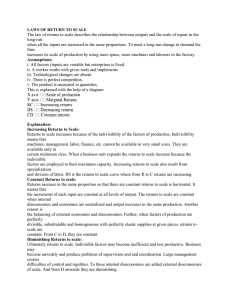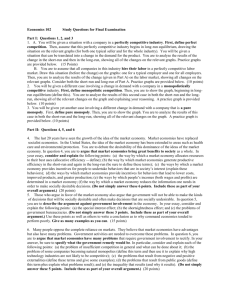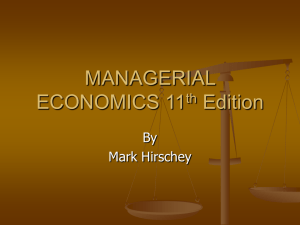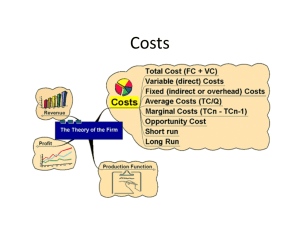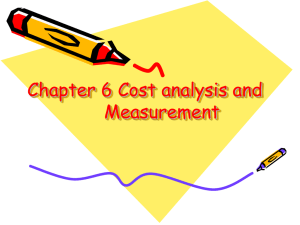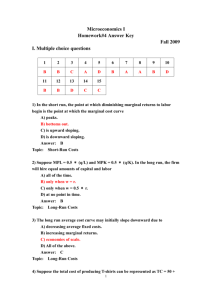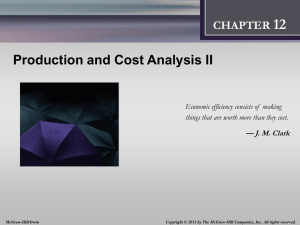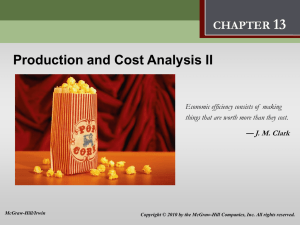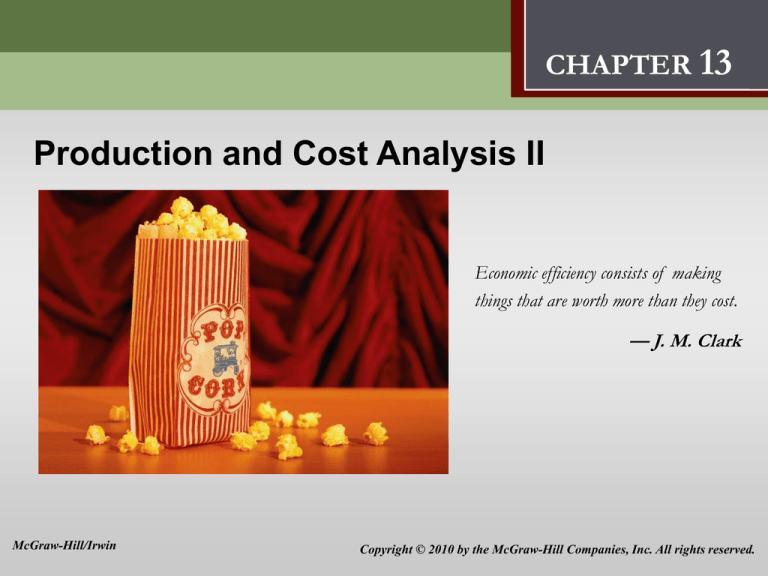
Production and Cost Analysis II
13
CHAPTER 13
Production and Cost Analysis II
Economic efficiency consists of making
things that are worth more than they cost.
— J. M. Clark
McGraw-Hill/Irwin
Copyright © 2010 by the McGraw-Hill Companies, Inc. All rights reserved.
Production and Cost Analysis II
13
Chapter Goals
• Distinguish technical efficiency from economic efficiency
• Explain how economies and diseconomies of scale
influence the shape of long-run cost curves
• State the envelope relationship between short-run cost
curves and long-run cost curves
• Explain the role of the entrepreneur in translating cost of
production to supply
• Discuss some of the problems of using cost analysis in
the real-world
13-2
Production and Cost Analysis II
13
Entrepreneurial Activity and the Supply Decision
• An entrepreneur is an individual who sees an
opportunity to sell an item at a price higher than the
average cost of producing it
• Entrepreneurs organize production
• They visualize the demand and convince
the owners of the factors of production that
they want to produce those goods
13-3
Production and Cost Analysis II
13
Using Cost Analysis in the Real World
• Some of the problems of using cost analysis in the realworld include the following:
• Economies of scope
• Learning by doing and
technological change
• Many dimensions
• Unmeasured costs
• Joint costs
• Indivisible costs
• Uncertainty
• Asymmetries
• Multiple planning and
adjustment periods
with many different
short runs
• And many more
13-4
Production and Cost Analysis II
13
Using Cost Analysis in the Real World
Economies of Scope
• The cost of production of one product often depends
on what other products a firm is producing
• There are economies of scope when the costs of
producing goods are interdependent so that it is less
costly for a firm to produce one good when it is already
producing another
• Firms look for both economies of scope and economies
of scale
• Globalization has made economies of scope even more
important to firms in their production decisions
13-5
Production and Cost Analysis II
13
Using Cost Analysis in the Real World
Learning by Doing and Technological Change
• Production techniques available to real-world firms are
constantly changing
• Learning by doing means that as we do something,
we learn what works and what doesn’t, and over time
we become more proficient at it
• Technological change is an increase in the range of
production techniques that leads to more efficient ways
of producing goods and the production of new and
better goods
• These changes occur over time and cannot be predicted
accurately
13-6
Production and Cost Analysis II
13
Using Cost Analysis in the Real World
Many Dimensions
• Most decisions that firms make involve more than one
dimension, including:
• Quality
• Packaging
• Shipping
• The level of output is the only dimension in the
standard model
• Good economic decisions take all relevant margins
into account
13-7
Production and Cost Analysis II
13
Using Cost Analysis in the Real World
Unmeasured Costs
• Economists include opportunity costs while accountants
use explicit costs that can be measured
• Economists include the owner’s opportunity cost which is
the forgone income that the owner could have earned in
another job
• In measuring the costs of depreciable assets, accountants
use historical cost which is what a depreciable item costs
in terms of money actually spent for it as the cost basis
• If the depreciable asset increased in value, an economist
would count its increased value as revenue
13-8
Production and Cost Analysis II
13
The Standard Model as a Framework
• The standard model can be expanded to include
these real-world complications
• Despite its limitations, the standard model provides
a good framework for cost analysis
• Introductory cost analysis provides a framework for
starting to think about real-world cost measurement
13-9
Production and Cost Analysis II
13
Chapter Summary
• An economically efficient production process must be
technically efficient, but a technically efficient process
may not be economically efficient
• The long-run average total cost curve is U-shaped
because economies of scale cause average total cost
to decrease; diseconomies of scale eventually cause
average total cost to increase
• Marginal cost and short-run average cost curves slope
upward because of diminishing marginal productivity
13-10
Production and Cost Analysis II
13
Chapter Summary
• The long-run average cost curve slopes upward because
of diseconomies of scale
• The envelope relationship between short-run and longrun average cost curves reflects that the short-run
average cost curves are always above the long-run
average cost curve, except at just one point
• An entrepreneur is an individual who sees an opportunity
to sell an item at a price higher than the average cost of
producing it
13-11
Production and Cost Analysis II
13
Chapter Summary
• Once we start applying cost analysis to the real world,
we must include a variety of other dimensions of costs
that the standard model does not cover
• Costs in the real world are affected by:
• Economies of scope
• Learning by doing and technological change
• Many dimensions to output
• Unmeasured costs, such as opportunity costs
13-12


